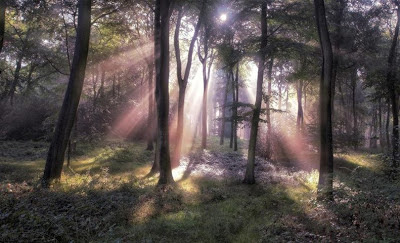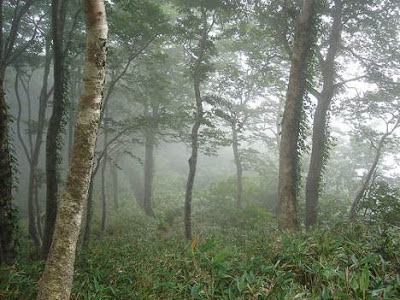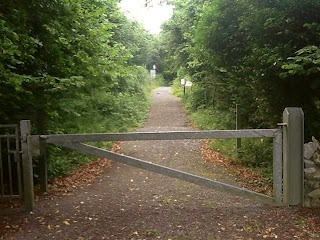Shinrin Yoku, Forest Bathing, in Ireland.
A Walk In The Woods, followed by a Picnic,
I find is the most fun way to spend a Saturday or Sunday, or both.
Add to that, several research reports published since 1980 have revealed health benefits beyond what anyone would expect.
Reports after reports reveal testimonials speaking about reduced blood pressure, reduced heart rate, reduced stress, reduced anxiety, reduced depression, reduced anger, and blessed clarity that releases emotional confusion ... all from being in the woods awhile
Writers express joy of inspiration after writer's block. Inventors become excited by visioning solutions to problems they have been working with.
People with very serious ailments have reported hallelujah relief and reductions of symptoms.
Even myself, a stroke victim with severe paralysis discovered that after repeated time in the forests all of my physical and mental functions returned.
The Japanese have set up a weekend walking in the woods tradition as
Shinrin Yoku, the Koreans call it Sanlimyok, the Finnish people are onto it,
but no national name yet, and for Ireland I'm going with Boladh na Sióga,
Bathing In The Fae's Breath.
More effective than Holistic Therapies?
With respect to holistic therapies and the years of training and experience gathering that practitioners dedicate to, I firmly believe their work can never be complete, can never be truly holistic, unless it includes a prescription for their clients to engage in some woodland exposure.
I believe Forest Bathing is not a replacement to their work
but an essential extension.
Embracing Our Senses
The emphasis of Forest Bathing is on richly embracing our five main senses
all at once ...
Vision
When we delightfully watch the sights of nature while walking in a beautiful forest, tests have indicated we experience decreases in blood pressure and heart rate. Reduced prefrontal activity in the brain that is experienced through feelings of calmness and happy elation. These benefits have tested to be much greater while in the forests than from just viewing pictures and videos of woodlands.
Smell
We associate scents with instincts, memories of emotions, and preferences when making choices. Within the forests we breath in fine airborne particles called phytoncides that are emitted from tree leaves, so conifers in winter are very beneficial to sustain this then. Similar to vision, through forest breathing and smelling ,blood pressure decreases and prefrontal activity slows down. Anxiety and depression is is also shed and our minds works more efficiently, especially clarity of imagination. Breathing also regulates better.
Touch
We love to hug trees, don't we? And what about the warm sun on your back and wind in your hair?Curiosity, connection and trust with trees, when we hug them, does reduce blood pressure, releases anxiety and elevates happiness.
Taste
Have you noticed that food tastes better outside? We love our picnics, and barbeques when we have them. Also, knowing what we can forage and eat provides us with a euphoria from eating good instant nutrition from nature.
Sound
It seems obvious that the sound of a stream is soothing, and so can the rustle of a gentle breeze moving through the leaves. Blood pressure calms, heart beat regulates and brain activity decreases.
The Japanese really pioneered this new awareness of forest therapy. Perhaps the Japanese were inspired by the 'parcour' forest exercise tracks in Switzerland since the 1960s. The Swiss model was inspired by the "Kneipp Therapy" formulated in Germany during the 19th century, which is really about taking brisk walks in the woods. This has been recently revived as the "Green Prescription" by some doctors in England, Wales and Donegal in Ireland.
Shinrin Yoku, Japanese for Forest Bathing, is much more leisurely than the brisk walk approach. It has also been influenced by past Shinto traditions.
In 1982, the Forest Agency of Japan proposed that forest bathing should be part of everyone quest to be healthy. Forests were chosen and converted into what are called Forest Therapy Bases. Japanese companies are now including forest therapy within employee health care benefits.
There are between 31 to 48 Forest Therapy Bases across Japan. These numbers change according to the reports I read. I have heard that some of these special forests were lost during the recent earthquake disaster and nuclear power station leakage disaster in Japan. Even so, Japan aims to have over 100 Forest Therapy Bases established by 2020.
At these Forest Bases the forest rangers record the heart rate and blood pressure rate of people arriving at the forest, and again as they leave. With these changing results they are aware of how much the forest may have helped them.
Meet Dr Li
Dr. Qing Li is considered to be a kind 'father of shinrin yoku'. He serves as a founder and president of the Japanese Society of Forest Medicine and is Vice-President and Secretary General of International Society of Nature and Forest Medicine. He actually created the Shinrin Yoku name.
Though a day or afternoon in a forest can benefit us for a week, Dr Li recommend spending two or three days in the wood during a week, if we can.
Dr Li is constantly exploring how a forest can be more potent as a healer, and this does involve some re-arrangements.
He looks for water features in a forest such as a bubbling river and a waterfall. To assist sounds he considers how the wind moves through the trees and the volume sounds made. Velocity of sounds has to be soothing and not demanding.
He measures the amount of volatile organic compounds present in the air derived from the trees, such as pinenes, limonenes, and a range of phytoncides, Together this is the overall natural aromatherapy of the forest.
He also evaluates forest environments such as how hot or cold they are, light or dark, quiet or noisy, and plain or colorful.
In an interview Dr Li concludes
"Imagine a new medical science that could let you know how to be more active, more relaxed and healthier with reduced stress and reduced risk of lifestyle-related disease and cancer by visiting forests. This new medical science is Forest Medicine. Nature and Forest Medicine will prevent people from cancers and lifestyle-related diseases such as heart disease, diabetes, cerebrovascular disease, depression and hypertension".
click here for the full Dr Li interview
Does Forest Bathing work in Ireland's Forests?
We are quite a distance away from forests in Ireland being declared as being
Forest Therapy Bases. Our biggest hurdle is perhaps lack of forest.
In Ireland less than 8% of the nation's land is covered in forest compared
to Japan's over 60% forest cover. 90% of Ireland's forest cover is
"grow like cabbages" sitka spruce and only 10%, 1% of the total land,
is covered in natural forest.
The upside, though, is that spruce is quite rich in pinenes, but obtaining them from actual pine trees and cedars is better for us.
Even so, by being in the Public Forests available to us in Ireland we are demonstrating our presence and interest. Together while walking and sharing our picnics we can debate, discuss and eventually campaign arrangements to convert our local woodlands into fitting our community needs. This could include preserving and arranging sections of forests to benefit our holistic health, relaxation and fitness needs.
Perhaps Ireland could look to Scotland more than Japan for examples of what could work here in Ireland. Scotland has an advantage because since 1982 the country has increased its forest cover from 9% to 17%. Scotland, has focused on forest strategies to improve tourism, local leisure and local health for over 30 years now.
The National Health Service and the Forestry Commission in Scotland have collaborated to provide a range of forest based activities that include the energetic 'parcours' like in Switzerland and a range of more leisurely opportunities to soothe people with anxiety, depression and mental health concerns. Some hospital grounds around Scotland have been re-designed to include more trees and tree walks. Even the seriously ill can now look out of hospital windows to see trees rather than concrete.
Another 'hero' in the Shinrin Yoku journey is Dr. Miyazaki who has followed through Forest Bathing as he believes that because humans evolved within natural settings, it’s where we feel most comfortable, but today most of us no longer know this.
Its as if we no longer believe we are of nature and that nature is something seperate to us. Even holistic practitioners talk of us and nature as two separate existences trying to find a bridge to connect rather than drop that denial and realize we are truly still a component of nature.
Dr. Miyazaki says “Throughout our evolution, we’ve spent 99.9% of our time in natural environments. Our physiological functions are still adapted to it. A feeling of comfort can be achieved if our rhythms are synchronized with those of these natural environments”.
Today it seems many of us spend 99.9% outside of natural environments so something is bound to go wrong.
Time left for the outdoors, especially within the forest has been almost eliminated.
Some of us seek to improve health and achieve relaxation by going off to other buildings away from our homes to take part in meditations, therapies and workshops. These practices I personally find most strange, doing holistic thingys in buildings "calling upon nature" to heal them and guide them. Some practitioners even lead chants and prayers asking for nature to accept our healing which I find the oddest of all, thinking that we humans may be healthier or are a conduit for health to heal our entire planet.
When I come across this I tend to think that I have yet to observe bees in a hive calling upon pollen and nectar to abundantly come to them. The bees have to get out there and get it, or it just does not happen.
We have to do the same, get out there and share all of the benefits offered by being among the trees, flowers, ferns, fungi, wildlife and all of the smells, tastes, sounds, visuals and not be afraid to touch and be touched. Being involved in the forests does become a balanced give and take.
Does other outdoor exercise count?
Do you think you are being healthy exercising in other outdoors pursuits? Many people outside are still tethered to their automatic data powered civilization such as having a heart monitor strapped on, wearing a blaring headset, carrying a smart phone on a belt for sending frequent texts and punching in facebook posts about how healthy they are being.
Evidence is mounting to confirm that to get the most out of nature, you really need to be truly present in it, and not present within your own great story of yourself inputted and outputted with and through data.
Children in the forests
I've seen articles and reports online that tell of children being taught in forest environments concentrating better than in a stuffy classroom, and that symptoms of Attention Deficit Hyperactivity Disorder (ADHD) are significantly reduced.
In the U.K., youths diagnosed with behavioural problems, and often criminalized by this, have responded positively to programs that include green woodworking, permaculture gardening and basics of woodland management.
Richard Louv, founder of the Children and Nature Network and writer of eight books on the benefits of integrating nature, family and community has explained “In 2006, a Danish study found that outdoor kindergartens were better than indoor schools at stimulating children’s creativity. The researchers reported that 58 percent of children who were in close touch with nature often invented new games; just 16 percent of indoor kindergarten children did.”
Dr. Stephen R. Kellert, professor emeritus at the Yale University School of Forestry and Environmental Studies wrote that children are engaged with electronic media, computers etc., on average 52 hours a week but typically spend less than 49 minutes outside. That has reversed how we have naturally lived for 1000s of years before now.
Kellert has also written "Our senses, our emotions, our intellect, even our spirit are developed in close association with and in adaptive response to the natural world. Our physical and mental health, productivity, and well being relies on direct and indirect connections to nature, even as our world becomes increasingly fabricated and constructed.”
Boladh na Sióga in Ireland
As Ireland is unlikely to be able to follow the Japanese Shinrin Yoku way for many years, if at all, we can reshape from the ancient forest culture tradition here.
Boladh na sióga is about being present in the breath of the Fae, the Sidhe, the Fairies. Much of Ireland mythology talks of the Fae among the trees. Maybe it is not clear when we consider who or what the fae is. Maybe Shinrin Yoku is quietly explaining this to us.
With the woodlands we have here in Ireland and the Future Forests we can create here, we can unconditionally allow and encourage the Sióga to breathe on us in the forest to calm us, feed us, inspire us, protect us and heal us.
Links to forest things you can do ...
click here to join Friends Of Forest Groups in your county
and nearby counties you can travel to
click here to see a listing of upcoming Walks In The Woods
If you would like to peruse the long and very dry research report
on Shinrin Yoku from the USA, click here
and for a very wordy research paper from Japan, click here
and to get involved with our Ireland's forests,
this is a very easy read, click here
Next post is going to be
12 Things you can do in the woods of Ireland
so please subscribe to this blog for this and more features.













Definitely consider that which you said. Your favourite
ReplyDeletejustification appeared to be at the net the simplest factor to remember of.
I say to you, I certainly get irked whilst people consider concerns that they just do not recognize about.
You controlled to hit the nail upon the highest and also defined out the whole
thing without having side-effects , people could take a signal.
Will likely be again to get more. Thanks
my blog :: bike computers online :: Photography-videos.com ::